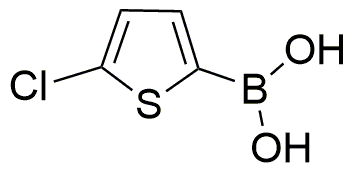5-Chloro-2-thiopheneboronic acid is widely utilized in research focused on:
- Organic Synthesis: This compound serves as a versatile building block in the synthesis of various organic molecules, particularly in the development of pharmaceuticals and agrochemicals.
- Cross-Coupling Reactions: It is commonly used in Suzuki-Miyaura coupling reactions, which are essential for forming carbon-carbon bonds in complex organic compounds, making it valuable in material science and drug discovery.
- Fluorescent Probes: The unique properties of this boronic acid allow it to be used in designing fluorescent probes for biological imaging, aiding researchers in studying cellular processes.
- Sensor Development: It plays a role in the development of chemical sensors for detecting sugars and other biomolecules, which is crucial in fields like diagnostics and environmental monitoring.
- Material Science: The compound is utilized in the production of conductive polymers and materials, enhancing the performance of electronic devices and sensors.
General Information
Properties
Safety and Regulations
Applications
5-Chloro-2-thiopheneboronic acid is widely utilized in research focused on:
- Organic Synthesis: This compound serves as a versatile building block in the synthesis of various organic molecules, particularly in the development of pharmaceuticals and agrochemicals.
- Cross-Coupling Reactions: It is commonly used in Suzuki-Miyaura coupling reactions, which are essential for forming carbon-carbon bonds in complex organic compounds, making it valuable in material science and drug discovery.
- Fluorescent Probes: The unique properties of this boronic acid allow it to be used in designing fluorescent probes for biological imaging, aiding researchers in studying cellular processes.
- Sensor Development: It plays a role in the development of chemical sensors for detecting sugars and other biomolecules, which is crucial in fields like diagnostics and environmental monitoring.
- Material Science: The compound is utilized in the production of conductive polymers and materials, enhancing the performance of electronic devices and sensors.
Documents
Safety Data Sheets (SDS)
The SDS provides comprehensive safety information on handling, storage, and disposal of the product.
Product Specification (PS)
The PS provides a comprehensive breakdown of the product’s properties, including chemical composition, physical state, purity, and storage requirements. It also details acceptable quality ranges and the product's intended applications.
Certificates of Analysis (COA)
Search for Certificates of Analysis (COA) by entering the products Lot Number. Lot and Batch Numbers can be found on a product’s label following the words ‘Lot’ or ‘Batch’.
Numéro de catalogue
Numéro de lot/série
Certificates Of Origin (COO)
This COO confirms the country where the product was manufactured, and also details the materials and components used in it and whether it is derived from natural, synthetic, or other specific sources. This certificate may be required for customs, trade, and regulatory compliance.
Numéro de catalogue
Numéro de lot/série
Safety Data Sheets (SDS)
The SDS provides comprehensive safety information on handling, storage, and disposal of the product.
DownloadProduct Specification (PS)
The PS provides a comprehensive breakdown of the product’s properties, including chemical composition, physical state, purity, and storage requirements. It also details acceptable quality ranges and the product's intended applications.
DownloadCertificates of Analysis (COA)
Search for Certificates of Analysis (COA) by entering the products Lot Number. Lot and Batch Numbers can be found on a product’s label following the words ‘Lot’ or ‘Batch’.
Numéro de catalogue
Numéro de lot/série
Certificates Of Origin (COO)
This COO confirms the country where the product was manufactured, and also details the materials and components used in it and whether it is derived from natural, synthetic, or other specific sources. This certificate may be required for customs, trade, and regulatory compliance.


